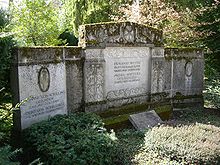Rudolf Nietzki
Rudolf Hugo Nietzki (born March 9, 1847 in Heilsberg in East Prussia , today Lidzbark Warmiński , Poland; † September 28, 1917 in Neckargemünd ) was a German chemist .
Life

Rudolf Nietzki was born in the small town of Heilsberg in 1847 as the son of the Protestant preacher , later pastor and writer Johann Karl Emil Nietzki and his wife Adelheid Marianne. Ebel born. He attended a grammar school in Königsberg , which he left in the lower prime to begin an apprenticeship as a pharmacist in Zinten and Creuzburg . After graduating as a pharmacy assistant in 1865, he worked as a pharmacist in Hirschberg in the Giant Mountains (today Jelenia Góra , Poland). During this time he made the acquaintance of the later inventor of chemotherapy and Nobel Prize winner , Paul Ehrlich . He began studying pharmacy in Berlin in 1867 and passed his state examination there in 1871 . In the Franco-German War he served as a military pharmacist and was taken prisoner by the French. From 1871 to 1874 he worked as a private assistant to August Wilhelm von Hofmann in Berlin and on March 14, 1874 in Göttingen he was promoted to Dr. phil. PhD . In the following years he worked as an industrial chemist for various chemical companies. In 1884 he completed his habilitation with Jules Piccard at the University of Basel , where he became an associate professor of chemistry in 1887 and a full professor in 1895. For health reasons, Nietzki retired in 1911 and moved to Freiburg im Breisgau .
Services
Nietzki made a decisive contribution to the scientific foundation of a new class of synthetic dyes obtained from coal tar . According to the " quinone hypothesis " he established in 1890, the color effect of these substances is due to quinone systems . In 1876 he analyzed the aniline black . 1878 he succeeded with the discovery of Biebrich scarlet producing the first tetra azo dye and soon after the pickling dye Alizarin Yellow R . In 1888 his highly regarded textbook on organic dyes was published and has been translated into several languages.
Fonts
- "About hexaoxybenzene derivatives and their relationships with croconic acid and rhodizonic acid", by R. Nietzki and Th. Benckiser, Reports of the German Chemical Society, Volume 18, 1885, pp. 499-515
- Chemistry of Organic Dyes, 1888, published by Julius Springer, Berlin, (5th edition 1906)
- 3rd edition - Berlin: Springer, 1897. Digitized edition of the University and State Library Düsseldorf
- Chemistry of the Organic Dyestuffs, by Rudolf Nietzki (Author), translated by A. Collin and W. Richardson, (reprinted as paperback, Verlag BiblioBazaar, 2008, ISBN 978-1-110-01837-6 )
literature
- Martin Kurz: Nietzki, Rudolf. In: Historical Lexicon of Switzerland .
- Holm-Dietmar Schwarz: Nietzki, Rudolf Hugo. In: New German Biography (NDB). Volume 19, Duncker & Humblot, Berlin 1999, ISBN 3-428-00200-8 , p. 248 ( digitized version ).
- Hans Rupe: Rudolf Nietzki. In: Reports of the German Chemical Society (A and B Series). 52, 1919, pp. A1-A28, doi: 10.1002 / cber.19190520128 .
- Chemistry of organic dyes , digitization of the 5th edition from 1906
- Chemistry of the Organic Dyestuffs, Transl. with Additions by A. Collin and W. Richardson , Digitization of Engl. Translation of the first edition from 1888, published in London 1892
- Rudolf Nietzki. 1847-1917. In: Helvetica Chimica Acta. 1, 1918, pp. 343-430, doi: 10.1002 / hlca.19180010133 .
Individual evidence
- ^ Richard Emil Meyer: Lectures on the history of chemistry , Akademische Verlagsgesellschaft, Leipzig, 1922, p. 237 f.
- ↑ Holm-Dietmar Schwarz, "Rudolf Nietzki", in Neue Deutsche Biographie, Volume 19, page 248, with further references.
| personal data | |
|---|---|
| SURNAME | Nietzki, Rudolf |
| ALTERNATIVE NAMES | Nietzki, Rudolf Hugo; Nietzki, Rudolph; Nietzki, Rudolf |
| BRIEF DESCRIPTION | German chemist |
| DATE OF BIRTH | March 9, 1847 |
| PLACE OF BIRTH | Heilsberg (East Prussia) |
| DATE OF DEATH | September 28, 1917 |
| Place of death | Neckargemünd |